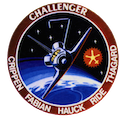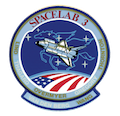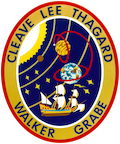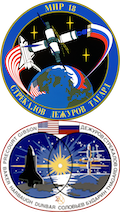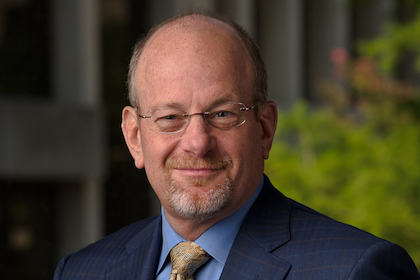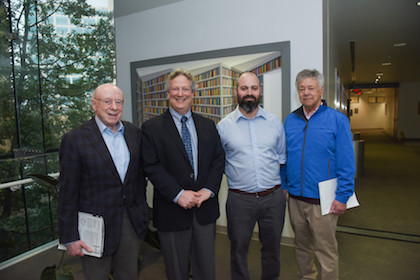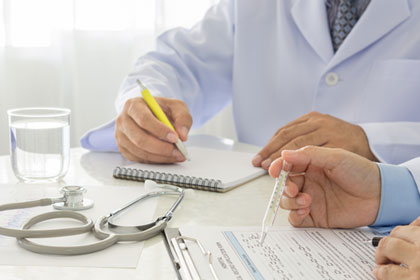Illustrious alumnus: Former astronaut Thagard recounts thrills of spaceflight
Dr. Norman E. Thagard, in town recently for his 40-year class reunion, took time away from his classmates to rekindle possibilities and launch dreams for current UT Southwestern Medical School students.
His Sept. 15 presentation covered some of the highlights of nearly two decades of NASA service and five missions as an astronaut. Upon his 1996 retirement from the space agency, Dr. Thagard had logged more than 140 days in orbit. His missions included sharing a flight with Dr. Sally Ride, America’s first female in space, as well as his own historic final mission to Russia’s Mir space station, which took three years of immersive preparation and training and earned him the unofficial title of “America’s cosmonaut.”
“There’s been some luck involved, but I’ve always tried to be prepared for when there was an opportunity,” said Dr. Thagard, who at 30 was the oldest student in a 154-member class when he enrolled at UT Southwestern in 1973.
Gautam Babu, a UT Southwestern medical student who majored in astronomy at Dartmouth College, found the talk enlightening and spent some time visiting with Dr. Thagard afterward.
“I’ve wanted to be an astronaut since I was 7 years old. Listening to him, it all became a reality again,” Mr. Babu said. “He’s down to earth, willing to encourage you, and remains humble. Basically, he’s everything you want a hero to be.”
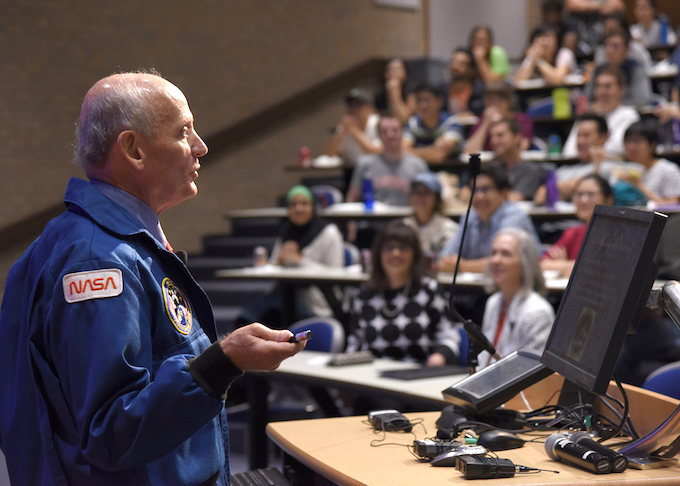
Dr. Thagard, inducted into the U.S. Astronaut Hall of Fame in 2004, returned to campus for his Class of 1977 reunion. Retired since 2010 after a subsequent career on the faculty of Florida State University, the trim 74-year-old Florida native has fulfilled most of his childhood aspirations – becoming an engineer, a jet pilot, a physician, an astronaut, and a college professor. Ever self-effacing, he is quick to point out that he didn’t accept a position as a test pilot when he exited the military and that his medical journey only began after FSU shut down its engineering school while he was working toward a Ph.D.
Playing the long shot
In 1977, Kirby Thagard turned on an early morning radio news broadcast, nudging into motion a cascade of circumstances that changed her husband’s life and set him on a historic career path.
The newscast mentioned that NASA was accepting astronaut applications for the first time in nearly a decade. She knew a perfect candidate – her husband, an older student at UT Southwestern Medical School with deep life experiences and a young family who was in his final year of schooling before the start of residency training.
“As a medical student, I never listened to the radio,” Dr. Thagard recalled. “I was lucky to sleep.”
Mrs. Thagard sent for the application packet, and her husband – an FSU electrical engineering graduate who had flown 163 combat missions over Vietnam while serving as a U.S. Marine aviator – filled out the paperwork and mailed it back to the space agency. Almost 8,100 others also applied for the 35 NASA spots.
Weeks passed, then months, and the dream faded. The couple and their two young sons – Gordon and James – celebrated the winter holidays. Mrs. Thagard, a special education teacher in Carrollton at the time, prepared to move with her husband, who had matched at the Medical University of South Carolina.
Shortly after relocating, Dr. Thagard received additional questionnaires and fingerprint forms to complete before he underwent interviews and exams at Johnson Space Center in October 1977. He was called during a preclinical meeting early in 1978. On the other end of the line was George Abbey, Director of Flight Operations at Johnson Space Center, with a simple question: “I’m calling to see if you were still interested in the astronaut position.”
The rides of his life
Five years after being accepted by NASA, Dr. Thagard flew aboard the shuttle Challenger and conducted medical tests on space adaptation syndrome, a common bout of nausea frequently experienced by astronauts early in spaceflights. “I was probably a good choice [to study space motion sickness] because I was the sickest one aboard,” he said. The crew included Dr. Ride and was preceded and followed by visits to the White House.
In the Houston suburb of Friendswood, however, the Thagards tried to maintain a typical home life, which by then included a third son, Daniel.
“Unless he was doing a mission, we were an ordinary family,” Mrs. Thagard said. “Your family is the pinnacle of what you can achieve, so nothing took us away from that aspect.”
Three more shuttle missions followed in the next nine years – aboard Challenger, Atlantis, and lastly Discovery. Dr. Thagard’s work in space included deploying the Magellan probe, which mapped the surface of the planet Venus by radar, and experiments for the first international microgravity laboratory aboard Discovery, where he was joined by three crew members about to embark on their maiden voyages, including Dr. Roberta Bondar, the first Canadian woman in space.
The 1992 mission included a last-minute discussion about facing the omnipresent dangers of spaceflight. “You just don’t dwell on that,” Dr. Thagard said. “We were at the 195-foot shuttle-boarding level and the subject came up. I said ‘At this point, it would take more courage to say no, I’m not going.’ We had a job to do. That’s the Marine way.”
Living Russian
The ever-proactive Dr. Thagard made a solo run to the Rice University bookstore in 1991. His mission? To locate and secure a Russian 101 language textbook.
The early 1990s were witnessing political détente between the U.S. and Russia, and President Bill Clinton’s administration seemed poised to engage Moscow in constructive space work in return for ending destabilizing practices, like exporting advanced rocket gear to developing countries. Word was spreading around NASA that the countries were quietly putting together a working plan. If that were true, Dr. Thagard wanted to take part.
Basic Russian was soon followed by self-taught second-year Russian from a textbook bought at the University of Houston bookstore.
Behind the scenes, talks were indeed ongoing. NASA’s checklist included selection of someone with medical training – and Dr. Thagard’s name was in the mix early, as was Dr. Drew Gaffney, a former UT Southwestern faculty member who had made his first NASA flight in June 1991 as a payload specialist aboard Columbia.
In 1992, Dr. Thagard was selected to represent NASA and the U.S. on the Russian space station Mir. After attending Russian language school in California (eight hours a day, five days a week, for 18 weeks), he trained for more than a year in Star City, Russia, for the 1995 MIR 18 mission. Mrs. Thagard and Daniel, then a high school freshman, lived in Star City for 10 months before Gordon and James, at that time enrolled in college, joined the family for the launch. Mrs. Thagard taught English and tutored Daniel, 15, while the family lived an isolated existence that included no English-language newspapers or news broadcasts, no video rentals, unreliable telephone communications, and a 75-minute drive to Moscow for groceries.
Dr. Thagard launched aboard the cramped Soyuz TM-21 capsule with cosmonauts Lt. Col. Vladimir Dezhurov and Gennady Strekalov on March 14, 1995, initiating a 115-day mission. Dr. Thagard’s longest previous spaceflight had been eight days. At the time, no American had remained in space more than 84 days, and that had occurred in the 1970s aboard NASA’s only space station, Skylab. At liftoff, Dr. Thagard became the first American launched in a Soyuz spacecraft, the first American to enter space aboard a non-American craft, and the first American occupant of the Mir.
“In Russia, I had to take courses and oral exams on Soyuz and Mir systems, sometimes from the very people who designed the systems,” Dr. Thagard said. “On the first day of training, an Air Force captain came into the classroom and started talking. I was greatly relieved when I realized I could understand what he was saying, so I knew I could accomplish the mission. We used the same pad from which Yuri Gagarin launched on April 12, 1961, when he became the first human in space.”
Still, the flight in 1995 was not without its ironic historical intersections.
“Our commander [Dezhurov] was a former MiG-21 pilot,” Dr. Thagard said. “American pilots went up against Soviet-trained MiG-21s over Vietnam. I never would have believed it if you had told me that 25 years after flying an F-4 Phantom in combat I would share a capsule with a Russian MiG-21 pilot.”
When handed lemons…
In June 1972, Dr. Thagard faced the what-are-you-going-to-do-next question. Working toward a Ph.D. in electrical engineering, the driven 28-year-old was caught flat-footed upon notification from Florida State that the School of Engineering was being closed.
“My mother-in-law reminded me that I always had told her I wanted to go to medical school and become a doctor,” he recalled. “She lived in San Antonio and happened to know the medical school dean. He agreed to assess my potential, informing me afterward that if I relocated, his school would likely admit me.”
The family loaded its belongings into a van and moved to San Antonio. “I picked up the local newspaper the first day there, and the headline on Page 1 read ‘Medical School Dean fired.’ We had to make another plan quickly,” Dr. Thagard said.
He applied to nine medical schools and was accepted by five despite many schools’ unofficial policies of rarely giving consideration to applicants older than their mid-20s. “There were some anti-war feelings, but I experienced more age discrimination than anything,” Dr. Thagard said. “Frankly, I went to the school with the best reputation and best value. Once I was enrolled at UT Southwestern, we were all the same. Some classmates knew I was older, but it didn’t make a difference.”
Enjoying life
Dr. and Mrs. Thagard first met when she was a freshman at FSU. Now married 52 years, they travel extensively, often with one or more of their grandchildren tagging along.
“We’ve had a blessed life,” said Mrs. Thagard. “You can’t prepare for the kinds of things we’ve done.”
NASA still brings him to Johnson Space Center for annual physicals as part of the Longitudinal Study of Astronaut Health. His time in space exposed Dr. Thagard to about half of the radiation exposure allowed by the federal government for the entire career of a typical radiation worker. On the Mir mission alone, he physically experienced 12 percent bone loss from the head of the femur thigh bone, a 20 percent drop of muscle volume in his calves and 15 percent in his thighs, along with a 20 percent real loss of red blood cells. In addition, testing showed that his aerobic capacity declined 30 percent from prelaunch to landing day.
“There was a toll, but it was an accepted part of the job,” Dr. Thagard said. “After being first selected, I asked the people at NASA, ‘Why me?’ They said they were looking for candidates who were pilots, or doctors, or engineers. I was all three when I interviewed.”

